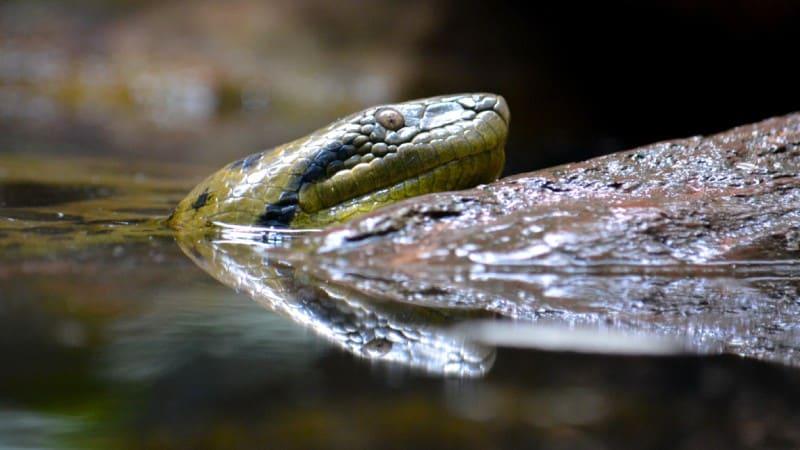
Green Anaconda Facts
- The descriptive term of Green Anaconda serves as the most frequently used common name for this incredible product of evolution. That’s not its only general title, though. Others include such terms as giant anaconda, common water boa, and giant anaconda.
- Within the scientific community, however, it’s perhaps better known by its technical moniker. Fortunately, that’s a much simpler tag for the layperson to pronounce than most such. The animal holds the formal designation Eunectes murinus.
- This marvel of Nature received that appellation due to the efforts of Carl Linnaeus himself. The eminnent Swedish biologist recorded the first recognition of it as a separate and distinct species. He achieved that scientifically noteworthy feat in 1758.
- This extraordinary reptile stands out in the annals of herpetology for several reasons. It’s both the largest and heaviest snake in the world. It’s also the second-longest known snake. The amazing creature also currently has no recognized subspecies.
- Thankfully, the remarkable Green Anaconda seems to be maintaining a population base that’s both stable and sufficient. This pleasant state further appears to hold true throughout the entirety of its range. The IUCN thus currently lists it as Least Concern.
- Yet, it nevertheless should be considered as facing potential threats to its survival as a species. As holds true for all forms of life on earth today, most of these stem from the actions of man. They include the dangers of habitat loss and climate change.
Related Articles
Green Anaconda Physical Description
The incredible Green Anaconda is a creation evolution that generally mesmerizes those who encounter it, especially if that meeting occurs out in the wild. That statement holds true for several reasons, though. That’s because the reptile impresses in a wide variety of ways.
The first of those understandably happens to be its sheer size. In that regard, however, the animal follows a pattern common to many animals. That’s in the fact that it displays a degree of the physiological trait of sexual dimorphism. In its case, that manifests physically.
More specifically, females of the species attain a larger average size than their male counterparts. These occasionally reach lengths equaling an astounding 29 ft (8.8 m)! Most specimens, though, generally remain somewhere between 15 – 17 ft (4.5 – 5.2 m) in length.
Males, meanwhile, typically do not come close to such magnificent measurements. For them, a mean total length equals between 9 – 13 ft (2.7 – 4.0 m). Though exceptional individuals sometimes occur, of course, even these rarely exceed these dimensions by much.
Likewise, the sexes also vary significantly in weight, with the females being much heavier. For the females, a mean mass equals 150 – 250 lb (68 – 113 kg). Exceptional examples sometimes reach 550 lb (250 kg). The male, though, only averages about 30 – 70 lb (13 – 32 kg).
Otherwise, the two genders present roughly the same outward appearance to the observer. The body naturally develops as quite elongated, thick, especially among females, muscular, and cylindrical. The skin also has an extremely smooth texture, aiding in swimming.
The head of the reptile, however, evolved as relatively small compared to the body and usually comparatively slender. It’s well-proportioned, though, with a slightly pointed snout. Both the eyes and nostrils developed efficiently positioned on top of the head.
The color of the Green Anaconda also gets attention. Its base color consists of an olive-green. Dark, round blotches also appear, spread across the body. These usually show black or dark brown and manifest in two rows along the back, often with smaller spots on the sides.
Its mouth additionally contains sharp, backward-facing teeth to grasp prey and powerful jaws to swallow prey whole. The scales on its underside uniquely evolved as relatively larger and keeled. This aids in moving across various terrains, including muddy riverbeds.
- Kingdom: Animalia
- Phylum: Chordata
- Class: Reptilia
- Order: Squamata
- Family: Boidae
- Genus: Eunectes
- Species: E. murinus
Green Anaconda Distribution, Habitat, and Ecology
The breathtaking Green Anaconda evolved as indigenous to a moderately broad expanse of the surface of the earth. The precise location of that zone of habitation, though, likely won’t surprise many people. That’s because it’s native to specific portions of South America.
Within the greater landmass, however, it only appears in the general nothern sections of the continent. Its range includes Brazil, Venezuela, Colombia, Ecuador, Peru, Bolivia, Guyana, Suriname, and French Guiana, as well as the island nation of Trinidad and Tobago.
The marvel of Nature displays an impressive degree of flexibility regarding its specific choice of habitat. All of these, though, do share certain very specific requirements. This remarkable snake indeed thrives in a wide variety of areas, provided they’re all wetland environments.
Slow-moving rivers typically comprise its primary choice for residency, however. Yet, despite its size, it also appears in smaller streams. Swampy areas and marshlands also provide the creature with ideal conditions. It’s even well-adapted to seasonally flooded forested areas.
The mighty Green Anaconda evolved as a pure carnivore. In this respect, it’s a purely opportunistic feeder with a diet that includes a variety of prey. This frequently includes such mammalian fare as capybaras, deer, and peccaries, or birds straying too close to the water.
The indiscriminate feeder also consumes other reptiles. Given their great size, this sometimes even includes caimans. Though not a primary prey, it also sometimes consumes fish. In all cases, it typically acts as an ambush predator, relying on stealth for its meal.
Breeding generally occurs during the dry season, from April to May. Females give birth to live young rather than laying eggs. The gestation period lasts about 6 -7 months, after which the female usually gives birth to 20 – 40 live young, though larger litters do occur.
Species Sharing Its Range
Check out our other articles on 5 Marvelous Mammals of California, Marine Iguana, Flume Gorge, Pinta Island Tortoise, Komodo Dragon, Common European Viper, Petra Iris, European Hornet
